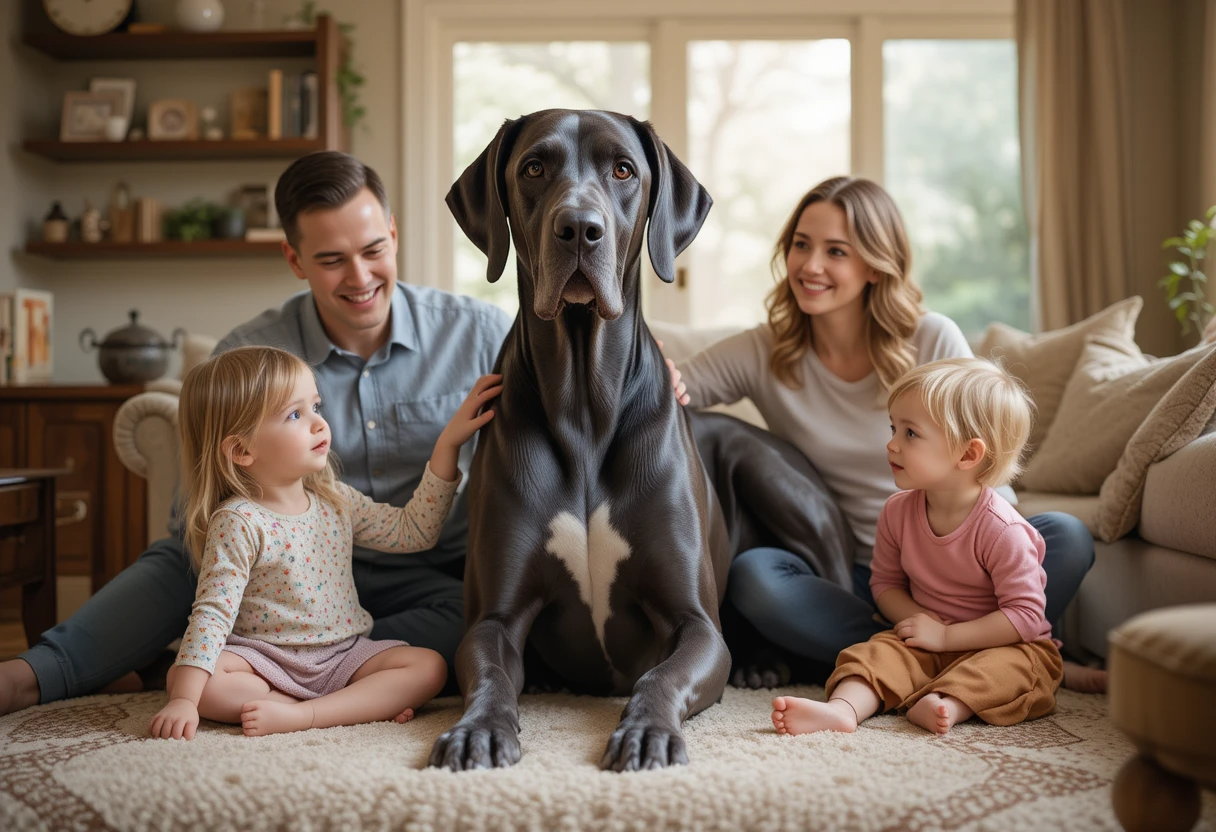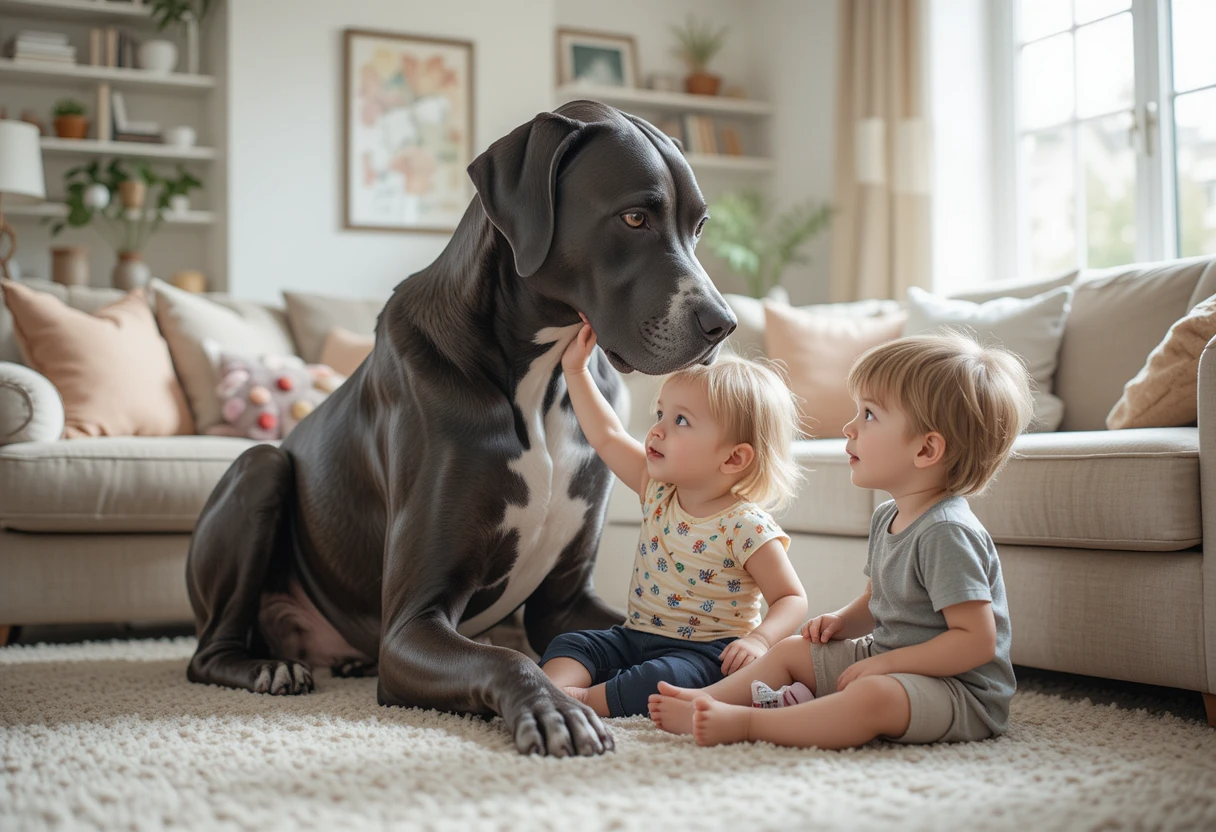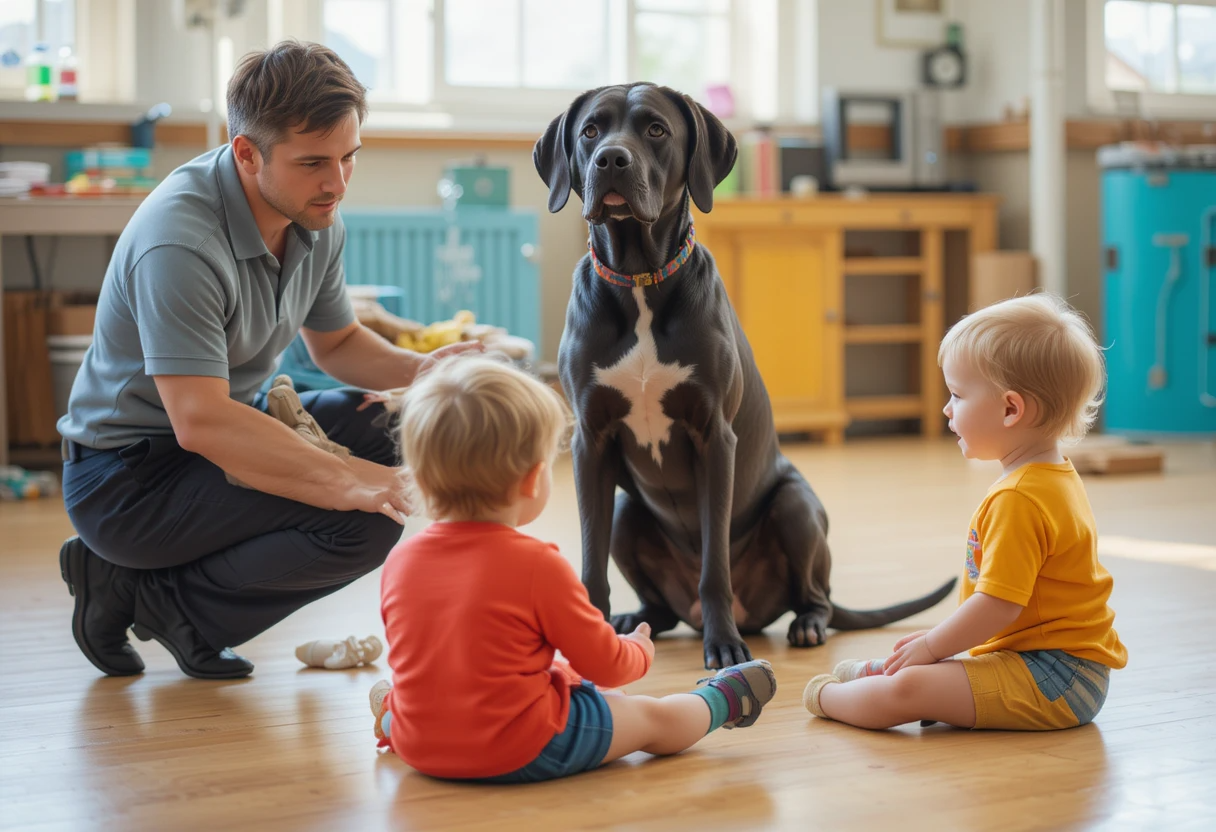When families consider adding a furry member to their household, size often becomes a primary concern—especially when small children are involved. Great Danes, towering at impressive heights and weighing as much as some adult humans, naturally raise questions about their compatibility with little ones.
Are Great Danes good with small kids? The answer might surprise you: these gentle giants can indeed make excellent companions for children, but there are important factors every parent should understand before making this decision.
Understanding the Great Dane: More Than Just Size
Great Danes have earned their reputation as “gentle giants” for good reason. Despite their imposing stature—males standing 30-32 inches tall and weighing 140-175 pounds, with females slightly smaller at 28-30 inches and 110-140 pounds—these dogs possess remarkably calm and affectionate temperaments that make them surprisingly suitable for family life.

The American Kennel Club consistently rates Great Danes as good with young children, noting their patient and tolerant nature. However, their massive size requires careful consideration and proper management when interacting with small kids.
The Gentle Giant Temperament
Great Danes exhibit several personality traits that make them potentially excellent family dogs:
Patient and Tolerant: These dogs typically display remarkable patience with children’s unpredictable behavior. They’re less likely to react aggressively to sudden movements or loud noises compared to many smaller, more high-strung breeds.
Calm Energy Level: Unlike many large breeds, Great Danes are relatively low-energy dogs. They’re content to lounge around the house and don’t require excessive exercise, making them more manageable around small children.
Loyal and Protective: Their natural loyalty to family members extends to children, often making them excellent watchdogs who will alert families to potential dangers while remaining gentle with family members.
Affectionate Nature: Great Danes are known for their desire to be close to their human family members—often forgetting their size and attempting to be “lap dogs.”
The Reality of Great Danes with Small Children

Size-Related Considerations
The most obvious concern when considering Great Danes with small kids is the sheer size difference. A fully grown Great Dane can easily weigh more than many adult humans, and their enthusiastic tail wagging alone can knock over a small child.
Accidental Injuries: Even the most well-intentioned Great Dane can accidentally injure a small child through normal behavior like:
- Enthusiastic greetings that might knock toddlers over
- Powerful tail wags that can sweep items off tables or hit small children
- Simply walking by and bumping into a child
- Playful behavior that’s appropriate for their size but overwhelming for small kids
Space Requirements: Great Danes need adequate space to move comfortably. In cramped quarters, the risk of accidental contact with small children increases significantly.
Positive Aspects of Great Danes with Children
Despite size concerns, many families successfully raise Great Danes alongside small children. According to expert behaviorists and veterinarians, properly socialized Great Danes often display exceptional gentleness with children.
Natural Gentleness: Many Great Dane owners report that their dogs seem to instinctively understand the fragility of small children and adjust their behavior accordingly.
Trainability: Great Danes are intelligent and generally eager to please, making them responsive to training that emphasizes gentle behavior around children.
Protective Instincts: Their size alone serves as a deterrent to potential threats, while their calm nature means they’re unlikely to overreact to normal childhood activities.
Training Great Danes for Family Life

Essential Training Areas
When preparing a Great Dane to live with small children, several training areas require special attention:
Boundary Training: Teaching your Great Dane to respect personal space is crucial. This includes:
- Not jumping on people
- Staying off furniture unless invited
- Respecting children’s play areas
- Understanding “gentle” commands
Impulse Control: Large dogs need excellent impulse control around small children. Training should focus on:
- Calm greetings
- Gentle mouth behavior (no mouthing or nipping)
- Controlled movement around children
- Appropriate play behavior
Socialization: Early and ongoing socialization with children of various ages helps Great Danes learn appropriate behavior. This should include:
- Exposure to different child behaviors (running, screaming, playing)
- Interaction with various age groups
- Learning to remain calm during chaotic situations
Professional Training Recommendations
Given the stakes involved with large dogs and small children, many experts recommend professional training. Great Dane training methods for families should emphasize positive reinforcement and consistency across all family members.
Professional trainers can help address specific concerns such as:
- Size-appropriate play behavior
- Emergency recall commands
- Stress signals recognition
- Safe interaction protocols
Supervision Requirements and Safety Guidelines
Constant Supervision Necessity
Supervision requirements for Great Danes and toddlers cannot be overstated. Even the most well-trained, gentle Great Dane should never be left unsupervised with small children. This supervision should be active and engaged, not passive observation from across the room.
Critical Supervision Moments:
- Feeding time (both dog and child)
- Play sessions
- When children have friends over
- During excitement or stress
- Anytime the dog shows signs of being overwhelmed
Establishing Safe Spaces
Creating designated safe spaces for both children and dogs helps prevent accidents and provides retreat options when needed.
Dog Safe Spaces:
- A comfortable bed or crate where the dog can retreat
- Areas where children are taught not to disturb the dog
- Feeding areas separate from child play zones
Child Safe Spaces:
- Play areas where dogs are not allowed
- Elevated sleeping arrangements if necessary
- Designated quiet zones for both species
Age Considerations: When Are Kids Ready for Great Danes?

Infants and Toddlers (0-3 years)
The combination of Great Danes and very small children requires the most caution. Toddlers’ unpredictable movements, loud vocalizations, and inability to understand boundaries can stress even the most patient dog.
Special Considerations:
- Never leave infants on floor level with an unsupervised Great Dane
- Be extremely cautious during the dog’s adjustment period to a new baby
- Watch for signs of jealousy or attention-seeking behavior
- Ensure the dog maintains its routine despite household changes
Preschool Age (3-5 years)
This age group can begin learning appropriate dog interaction skills while still requiring close supervision.
Teaching Opportunities:
- Basic dog safety rules
- Gentle touching and petting techniques
- Understanding when to give the dog space
- Simple commands they can use with the dog
School Age (6+ years)
Older children can take on more responsibility in dog care while developing stronger relationships with family Great Danes.
Increased Responsibilities:
- Helping with basic care tasks (under supervision)
- Learning to read dog body language
- Participating in training sessions
- Understanding emergency procedures
Health and Longevity Considerations
Lifespan Realities
One challenging aspect of Great Danes as family pets is their relatively short lifespan. Great Danes typically live 7-10 years, significantly shorter than many other breeds. For families with young children, this means potentially dealing with the loss of a beloved pet while children are still young and may struggle to understand death.
Preparing Families:
- Discussing pet longevity before adoption
- Creating meaningful memories throughout the dog’s life
- Preparing age-appropriate explanations for children
- Considering the timing of adding a Great Dane to the family
Common Health Issues
Great Danes are prone to several health conditions that can affect their interaction with children:
Bloat (Gastric Dilatation-Volvulus): This life-threatening condition requires immediate veterinary attention and can cause sudden behavioral changes.
Hip Dysplasia and Joint Issues: These conditions may cause pain and irritability, potentially affecting the dog’s tolerance for children’s activities.
Heart Conditions: Some Great Danes develop heart problems that may affect their energy levels and interactions.
Comparing Great Danes to Other Family Dog Breeds

Size Comparison with Popular Family Breeds
When considering Great Dane vs other breeds for children compatibility, it’s helpful to understand how they compare:
Great Dane vs Labrador Retriever:
- Labs are smaller (55-80 lbs) and often more energetic
- Both breeds are generally good with children
- Labs may be better for very active families
- Great Danes require less exercise but more space
Great Dane vs Golden Retriever:
- Golden Retrievers (55-75 lbs) are more manageable in size
- Both are gentle and patient with children
- Goldens typically live longer (10-12 years)
- Great Danes may be calmer indoors
Great Dane vs German Shepherd:
- German Shepherds (50-90 lbs) are more protective by nature
- Both require consistent training
- Great Danes are generally more relaxed
- German Shepherds may be better guard dogs
Advantages of Great Danes for Families
Despite size concerns, Great Danes offer several unique advantages as family pets:
Lower Exercise Requirements: Unlike many large breeds, Great Danes don’t require hours of daily exercise, making them suitable for busy families.
Apartment Living: Surprisingly, Great Danes can adapt to apartment living better than many smaller, high-energy breeds.
Calm Indoor Presence: Their low energy levels indoors make them less disruptive to household routines.
Natural Deterrent: Their size alone provides security benefits without aggressive tendencies.
Real-World Experiences: Families Living with Great Danes
Success Stories
Many families report positive experiences raising children alongside Great Danes. Common themes include:
Unexpected Gentleness: Parents frequently comment on how naturally gentle their Great Danes are with small children, often showing more patience than with adults.
Strong Bonds: Children and Great Danes often develop particularly strong relationships, with the dogs becoming protective guardians and loyal companions.
Teaching Opportunities: Living with a large dog teaches children responsibility, empathy, and respect for animals.
Challenges Faced
However, honest accounts also reveal common challenges:
Space Management: Many families underestimate the space requirements and find their homes feeling cramped.
Accidental Injuries: Minor injuries from enthusiastic greetings or tail wags are common, especially during the first year.
Training Consistency: Maintaining consistent training across all family members proves challenging for some families.
Veterinary Costs: The size of Great Danes often translates to higher veterinary bills, which can strain family budgets.
For a peaceful night’s sleep for your puppy, check out our guide on Best Crate Schedule for Puppy at Night: Sleep Peacefully with This Easy Routine.
Professional Recommendations and Expert Opinions
Veterinary Perspectives
Veterinarians generally support Great Dane ownership in families with children, provided certain conditions are met:
Proper Socialization: Early exposure to children and ongoing socialization throughout the dog’s life.
Consistent Training: Professional training or extensive owner education in large breed management.
Adequate Resources: Sufficient space, time, and financial resources to properly care for a giant breed.
Realistic Expectations: Understanding the breed’s limitations and requirements.
Animal Behaviorist Insights
Professional animal behaviorists emphasize several key points about Great Danes and children:
Individual Variation: Like all dogs, Great Danes are individuals, and temperament can vary significantly between dogs.
Environmental Factors: The dog’s early experiences, training, and ongoing environment significantly impact their suitability for family life.
Management Over Suppression: Rather than trying to suppress natural behaviors, successful families learn to manage interactions effectively.
Making the Decision: Is a Great Dane Right for Your Family?
Assessment Criteria
Before deciding if Great Danes are good with small kids in your specific situation, consider these factors:
Housing Situation:
- Do you have adequate space for a giant breed?
- Is your home layout suitable for managing interactions?
- Do you have secure outdoor space?
Family Dynamics:
- Ages of children in the household
- Experience level with dogs
- Consistency in training approaches
- Time available for supervision
Resources Available:
- Financial capacity for giant breed ownership
- Time for training and exercise
- Access to professional training if needed
- Veterinary care considerations
Long-term Commitment:
- Understanding of breed-specific needs
- Preparation for shorter lifespan
- Commitment to ongoing training and management
Red Flags: When Great Danes Might Not Be Suitable
Certain situations make Great Dane ownership inadvisable for families with small children:
Very Limited Space: Cramped living conditions increase accident risks significantly.
Inconsistent Supervision: Families unable to provide consistent supervision should reconsider.
First-time Dog Owners with Toddlers: The combination of inexperience and high stakes may be overwhelming.
Multiple Small Children: Managing interactions becomes exponentially more complex with multiple young children.
Financial Constraints: Giant breed ownership is expensive; cutting corners on training or healthcare isn’t advisable.
For new Great Dane owners, following a proper routine is crucial. You can check out this helpful guide on Puppy Schedule 8 Weeks Old – Free, Vet-Approved Daily Routine Inside to set the right schedule from the start.
Training Children to Interact Safely with Great Danes
Age-Appropriate Education
Teaching children how to interact safely with Great Danes is as important as training the dog itself.
Toddlers (2-3 years):
- Simple rules: “Gentle touches only”
- Stay away from the dog’s food
- Don’t pull on ears or tail
- Always have mommy or daddy present
Preschoolers (4-5 years):
- Understanding basic dog body language
- Appropriate petting techniques
- When to give the dog space
- Emergency procedures (calling for help)
School Age (6+ years):
- More complex body language recognition
- Helping with basic care under supervision
- Understanding the dog’s needs and feelings
- Taking some responsibility for interactions
Common Mistakes to Avoid
Parents often make well-intentioned mistakes that can compromise safety:
Assuming Size Equals Temperament: Large dogs aren’t automatically more aggressive, but they can cause more damage accidentally.
Insufficient Supervision: Even brief moments of unsupervised interaction can result in accidents.
Inconsistent Rules: Different family members enforcing different rules confuses both children and dogs.
Ignoring Warning Signs: Dismissing growls or other stress signals can lead to escalation.
FAQs
Great Danes can be good with babies, but their size makes supervision absolutely critical. Most Great Danes show natural gentleness around infants, but their sheer size means even gentle interactions can be dangerous. Proper introduction, constant supervision, and establishing boundaries are essential when bringing a baby into a home with a Great Dane or introducing a Great Dane to a family with a baby. Are Great Danes naturally good with babies?
What age child is best for a Great Dane?
Children aged 6 and older are generally better suited for Great Dane ownership, as they can understand and follow safety rules more effectively. However, with proper supervision and training, Great Danes can live successfully with younger children. The key is ensuring adequate adult supervision and teaching children appropriate interaction methods from an early age.
Do Great Danes bite children more than other breeds?
Statistics show that Great Danes are actually involved in relatively few bite incidents compared to many other breeds. However, when incidents do occur, their size can make injuries more severe. Proper socialization, training, and supervision significantly reduce bite risks. Most Great Dane-related injuries to children are accidental rather than aggressive.
How much supervision do Great Danes need around toddlers?
Great Danes require constant, active supervision around toddlers. This means an adult should be present and actively monitoring all interactions, ready to intervene immediately if necessary. Even the most well-trained Great Dane should never be left alone with a toddler, as accidents can happen in seconds due to the size difference.
Can Great Danes accidentally hurt small children?
Yes, Great Danes can accidentally hurt small children simply due to their size and enthusiasm. Common accidental injuries include being knocked over by enthusiastic greetings, being hit by powerful tail wags, or being stepped on. These accidents are preventable through proper training, supervision, and establishing safe interaction protocols.
You should also read our detailed guide on 15 Dangerous Signs in Dogs You Should NEVER Ignore to keep your pet safe and healthy.
Conclusion
Are Great Danes good with small kids? The answer is nuanced: they can be excellent family companions when properly managed, but they require significant commitment, training, and supervision. Their gentle temperament and patient nature make them potentially wonderful with children, but their imposing size demands respect and careful management.
Successful Great Dane families share common characteristics: adequate space, consistent training approaches, realistic expectations, and unwavering commitment to supervision. They understand that owning a gentle giant isn’t just about having a large, friendly dog—it’s about creating a safe, structured environment where both children and dogs can thrive.
For families considering this breed, the decision should be based on honest assessment of your situation, resources, and commitment level. With proper preparation, training, and ongoing management, Great Danes can indeed be wonderful additions to families with children, creating bonds that last a lifetime—albeit a shorter one than many would prefer.
The key to success lies in understanding that Great Danes and small children can coexist beautifully, but only when families are prepared for the unique challenges and rewards that come with sharing their lives with one of nature’s most impressive gentle giants.
Remember, every dog is an individual, and while breed characteristics provide helpful guidelines, your Great Dane’s specific temperament, training, and socialization will ultimately determine their suitability for your family. When in doubt, consult with professional trainers, veterinarians, and experienced Great Dane owners to make the best decision for your family’s unique situation.
You may also like to read our guide on Top 8 Best Big Dog Breeds For Apartments to find more large breeds that fit perfectly in smaller living spaces.

